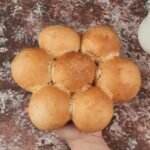Making your own white bread from scratch is a rewarding experience. The smell of freshly baked bread wafting through your home is irresistible, and the taste of warm, soft bread straight from the oven is unbeatable. Whether you’re enjoying it with butter, making a sandwich, or just savoring a slice on its own, homemade white bread has a comforting, soft crumb with a perfect golden crust.
Let’s dive into this simple and foolproof recipe for homemade white bread that’s sure to impress!
Ingredients:
- 3 1/2 cups (440g) all-purpose flour (plus extra for dusting)
- 1 1/2 teaspoons salt
- 1 tablespoon sugar
- 2 teaspoons instant yeast (or active dry yeast)
- 1 1/4 cups (300ml) warm water (around 110°F/43°C)
- 2 tablespoons unsalted butter, softened (or vegetable oil)
- 1 tablespoon milk (optional, for extra softness)
- 1 teaspoon vinegar (optional, for softer bread texture)
Instructions:
Step 1: Activate the Yeast
- Prepare the Yeast: In a small bowl, combine the warm water (not too hot, or it will kill the yeast), sugar, and instant yeast. Stir well to dissolve the sugar and yeast in the water.
- Let It Sit: Allow the mixture to sit for 5-10 minutes. The yeast should become foamy and bubble up. This step ensures the yeast is active and ready to make the dough rise.
Step 2: Make the Dough
- Mix the Dry Ingredients: In a large bowl, combine the all-purpose flour and salt. Mix well.
- Add Wet Ingredients: Once the yeast mixture is bubbly and foamy, pour it into the flour mixture along with the softened butter and optional milk and vinegar. Mix together until a dough starts to form.
- Tip: You may need to add a little more flour if the dough feels too sticky, but be careful not to add too much as you want the dough to remain soft and slightly tacky.
Step 3: Knead the Dough
- Knead the Dough: Turn the dough out onto a lightly floured surface. Knead the dough for about 8-10 minutes until it becomes smooth, elastic, and slightly tacky. You can also use a stand mixer with a dough hook to knead the dough on medium speed for about 5-7 minutes.
- Tip: If the dough is sticking to your hands, dust your hands lightly with flour. Be careful not to add too much flour, as this can make the bread dense.
- Check the Dough: When you press the dough with your finger, it should spring back gently. This indicates the dough has been kneaded properly.
Step 4: First Rise
- Let the Dough Rise: Place the kneaded dough in a lightly greased bowl (you can use a little vegetable oil or butter). Cover the bowl with a clean kitchen towel or plastic wrap.
- Rise for 1-2 Hours: Allow the dough to rise in a warm place for 1 to 2 hours, or until it has doubled in size. You can let it rise in a slightly warm oven (turned off) or in a warm spot in your kitchen.
- Tip: If you’re short on time, you can also let the dough rise in the refrigerator overnight for a slower fermentation, which can add more flavor to the bread.
Step 5: Shape the Dough
- Punch Down the Dough: After the dough has risen, punch it down gently to release any air bubbles. Turn it out onto a lightly floured surface.
- Shape the Dough: Roll the dough into a rectangular shape (about 10 inches by 8 inches). Then, fold the edges over to form a log shape, pinching the seams together to seal the dough.
- Tip: If you want a traditional loaf shape, tuck the edges of the dough underneath as you roll it into a loaf, forming a smooth top.
Step 6: Second Rise
- Prepare the Pan: Grease a 9×5-inch loaf pan or line it with parchment paper.
- Place the Dough in the Pan: Transfer the shaped dough into the prepared loaf pan. Cover it with a clean towel and let it rise again for about 30-60 minutes, or until it has doubled in size. The dough should rise slightly above the top of the pan.
Step 7: Bake the Bread
- Preheat the Oven: While the dough is rising, preheat the oven to 375°F (190°C).
- Bake: Once the dough has risen and filled the pan, place the pan in the oven and bake for 25-30 minutes, or until the bread is golden brown on top and sounds hollow when tapped on the bottom.
- Tip: If you like a crispier crust, you can mist the oven with water or place a small pan of water in the oven while baking. This will create steam and help develop a nice crust.
- Optional Egg Wash: If you prefer a shinier, golden crust, you can brush the top of the loaf with a little milk or an egg wash (1 egg beaten with 1 tablespoon of water) just before baking.
Step 8: Cool the Bread
- Cool the Bread: Once the bread is done baking, remove it from the oven and let it cool in the pan for 5-10 minutes. Then, turn the bread out onto a wire rack to cool completely.
- Tip: Allow the bread to cool completely before slicing. This helps set the texture and prevents it from becoming doughy in the center.
Step 9: Serve and Enjoy!
- Slice the freshly baked white bread and enjoy it with butter, jam, or as a base for sandwiches.
Tips and Variations:
- Bread Machine: You can also make this dough in a bread machine. Add the ingredients to the bread machine in the order recommended by the manufacturer, then use the dough setting and proceed to the second rise and baking steps.
- Add Flavor: To enhance the flavor, you can add a tablespoon of honey, a dash of garlic powder, or fresh herbs like rosemary or thyme to the dough while mixing.
- Whole Wheat Version: You can substitute part of the all-purpose flour with whole wheat flour for a healthier version of this bread. Start with a 1:1 ratio and adjust as needed, but keep in mind the texture may change slightly.
- Freezing the Bread: If you’re not going to eat the entire loaf right away, you can freeze it. Let the bread cool completely, then wrap it tightly in plastic wrap or foil and store it in the freezer for up to 3 months. To thaw, simply leave it at room temperature for a few hours.
Why You’ll Love This White Bread Recipe:
This homemade white bread is soft, fluffy, and perfectly golden-brown. The process is simple, and with just a few ingredients, you’ll end up with a loaf that’s far superior to store-bought bread. The comforting aroma of baking bread fills the kitchen, and the texture is light yet hearty enough to make sandwiches or enjoy on its own. Whether you’re a beginner or a seasoned baker, this recipe is easy to follow and produces delicious results every time.
So, get ready to make your own white bread, and enjoy the homemade goodness with every slice!

Hayyat is a talented content writer and digital marketer with expertise in SEO, social media management, and online marketing. She excels at creating impactful, data-driven content to help businesses connect with their target audience and achieve measurable outcomes.



